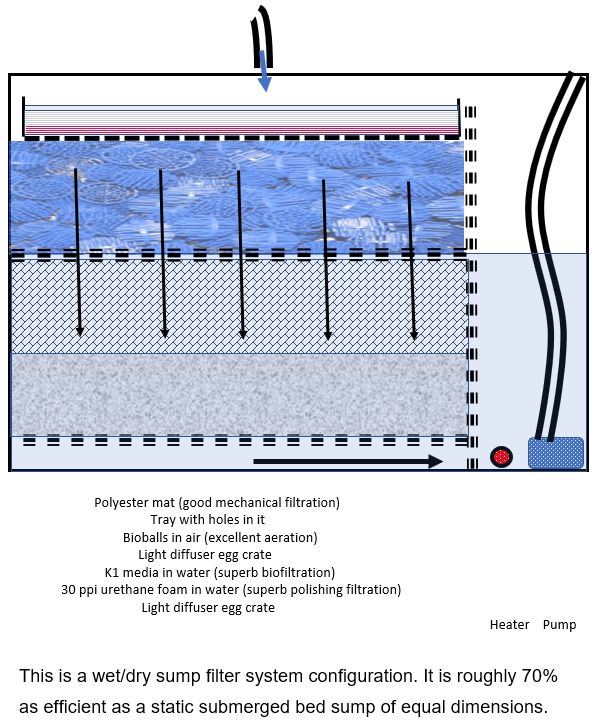Wet-dry filters are a hybridized version of the trickle sump filter where some submerged static biomedia is added. This gives better biofiltration than a trickle filter but is still only about 70% as efficient as a static media submerged bioballs filter. A 100% bioballs wet dry sump will have only about 10% of the efficiency of a fluidized bed K1 sump. And wet dry sumps can be exceedingly difficult to get a good “trickle”, with no channeling or overflow.
The best thing to do with any wet dry filter is to simply convert it to a completely submerged filter. Change the media out to pot scrubbers, 20 ppi foam or submerged K1 media. And you will have a MUCH better filter. For the optimum convert it to a K1 fluidized bed.

Wet Dry Filters in Depth
In a typical wet-dry filter the initial media met by the incoming gravity fed water flow from the aquarium is a mechanical filter such as the “pinky” polyester floss matting material. This matting is in a tray which has holes in the bottom of it. The tray is roughly two inches deep. The tray sits at least one inch deep in the sump so if it overflows it won’t go on the floor.
The holes in the tray drip the water onto a height of bioballs which is one third to one half the remaining height. This is The water dribbles through the bioballs becoming well aerated. Unfortunately most designs of wet dry sumps then just put the water through submerged bioballs. Submerged bioballs are a poor media.
The design is much better than a 100% bioball design. The water in this optimized design is spread out by a pinkie pad in a holed tray. It then trickles through some height of bioballs, aerating the water, Then it flows though static K1 medai and 20 pores per inch Porete urethan foam. The K1 and the foam will do excellent biofiltration.

The number of holes in the tray in these trickle tray designs is problematic. Too few holes and the tray overflows. Too many holes and the water isn’t spread out evenly over the bioballs. One can more easily input the water to the polyester mat via a holed pipe design. Put one holed pipe every three to four inches over the polyester.
The bottoms of the pipe have 1/8th inch holes every three inches. The sides of the pipe have two rows of 3/16th inch holes every two inches. And the tops of the pipes have 3/8th inch holes every inch. This insures relatively even distribution of the flow.
Note we do not recommend this filter design. It only makes the best of a bad design.

Sumps in More Depth
For more information on sumps click on the following links:
8.6.2. Static Submerged Media Sumps
Note that many beginners are concerned about how to flow the water to a sump. The common refrain is “my aquarium isn’t drilled, how does the water get to the sump?” Click on this link to get some ideas:


